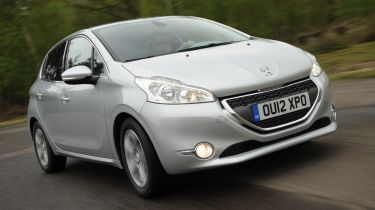Peugeot 208 1.2 Active
The Peugeot 208 aims to move the French brand's supermini game on to a new level
The Peugeot 208 has a lot to live up to. The 205 of the eighties is a legend, the 206 was the best-selling Peugeot ever and, despite its age, the 207 was the fourth most popular supermini in the UK last year.
Fortunately, if first impressions are anything to go by, Peugeot could have another winner on its hands. The 208 is smaller than the car it replaces, and is a compact and stylish-looking design.
It retains a clear visual link to its predecessors, but the satin-finish grille, sculpted bonnet and defined shoulder lines have helped it take a notable step upmarket.
It’s much the same story inside, where the classy cabin sets new standards for a small Peugeot. A tactile mix of metal trim and soft-touch plastics is complemented by an attractive, curved dashboard design. The car in our pictures is an Allure, but even our Active test car gets a colour touchscreen, which adds an executive feel to the interior.
The touchscreen operates the stereo and Bluetooth, and can also incorporate a series of bespoke apps and the optional sat-nav. However, until you’re familiar with it, the set-up is a bit fiddly to work on the move.
But by far the most frustrating ergonomic flaw is the raised position of the instruments. Despite trying all the steering wheel settings, our testers found their view of the dials fully or partly obscured by the wheel rim.
This major issue aside, the cabin has a swish ambience and comfortable seats. Passengers are well catered for, too. Even though the exterior is more compact than before, interior room is unchanged, thanks to redesigned seats that free up extra space. The boot has grown by 15 litres to 285 litres, but the other cars are just as practical.
Where the 208 has a clear advantage is under the bonnet. The all-new three-cylinder engine is refined, efficient and clean. However, despite its tiny capacity and cylinder deficit to its rivals, it has a lovely linear power delivery and feels surprisingly sprightly on the open road.
In fact, in-gear performance is much stronger than in the other cars – helped by the fact the 208 weighs only 975kg. Better still, it’s so smooth, you could forget it’s a three-cylinder. At motorway speeds, the engine is impressively subdued and, as the cabin isolates road noise really well, the Peugeot feels very grown-up.
Impressive efficiency is the icing on the cake: the car emits only 104g/km of CO2 and claims 62.8mpg fuel economy – although as our test car had a very low mileage, we averaged only 38.9mpg.
Nevertheless, Peugeot’s new generation of three-cylinder petrol engines gives the 208 a big advantage – at least until the Fiesta is upgraded with Ford’s new three-cylinder EcoBoost engines later this year.
Sadly, the car’s chassis doesn’t have a similar edge over the Fiesta. In fact, the Peugeot can’t match the way the Ford rides and handles. The light steering is positive and the 208 darts into corners, but there’s none of the natural feedback that makes the Fiesta so enjoyable.
And while there’s a decent level of grip, a degree of body roll means the 208 depends on its slightly intrusive stability control, rather than a nicely set up chassis, to keep things under control as you near the limit.
Having said that, in most everyday motoring situations the newcomer is composed and remains unfazed. The suspension doesn’t deal with broken road surfaces as well as the Fiesta, but it’s more comfortable than the Rio, and generally the cabin is pretty quiet.
Great to look at, well equipped and upmarket, the 208 is sure to be a hit, especially with such a great engine. On the other hand, a slightly underwhelming driving experience and a glaring ergonomic fault in the positioning of the instruments take the edge off this accomplished and competitively priced supermini.
Details
Chart position: 1WHY: On sale on 28 June, new 208 is smaller on the outside, bigger on the inside and more efficient than the 207 it replaces.







